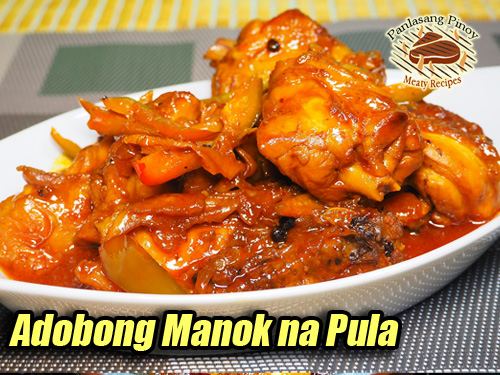Basically this adobong manok na pula is very simple. Just like the usual adobong manok with a twist by adding annato seeds extract to make the chicken adobo reddish in color and some slices of bell peppers. It will not actually turn red but a little yellowish reddish orange because the annato seed extract has this characteristic although the seed itself is dark red. The taste also is a bit different because of the annato seeds and I’m sure you will love it!
Have you heard the song manok na pula? There is a controversy regarding that song because the composer of that song is accusing a Youtuber that he stole the song. But the composer didn’t use an original background music and used Anne Murray’s song “Just Another woman in Love”. Oh well so much for that story what is important is this recipe I have here. I think this will be a good recipe for the manok na pula in that song hehehe.
Adobong Manok na Pula: The Song That Inspired a Dish
I still remember the first time I heard the song Manok na Pula. My cousin, Jun, played it on his phone while we were preparing dinner, and we all laughed at the lyrics. It wasn’t long before we found ourselves in a heated debate about the song’s origins—turns out, there was some controversy about it! But that’s a story for another day. What really stuck with me was the thought: What if the manok na pula in the song was actually a delicious dish instead of a fighting rooster? And that’s how I ended up making this special version of adobo— adobong manok na pula.
A Unique Twist on a Classic Dish
If you grew up in a Filipino household, chances are you’ve had adobo in all its glorious forms—chicken, pork, with coconut milk, or even crispy fried. But this version has a little extra charm, thanks to atsuete (annatto seeds), which gives it that deep orange-reddish hue. My uncle Lando from Batangas swears by this technique, and when I tried it for the first time, I understood why. The subtle earthiness from the annatto oil, combined with the rich soy sauce and tangy vinegar, creates a flavor profile that is both familiar and excitingly new.
Why Use Annatto Seeds?
Annatto seeds have been used in Filipino cooking for generations. They don’t just add color; they also bring a mild, peppery, and slightly nutty taste to dishes. My Lola Ising used to say that annatto oil makes everything look more festive. When I was younger, I thought it was just for decoration, but now I appreciate the depth it adds to the dish. The secret to getting the perfect shade is to fry the seeds in hot oil just long enough to extract their natural color without burning them. This process ensures that the oil becomes deeply infused with flavor before it coats every piece of chicken.
Cooking Adobong Manok na Pula the Right Way
The process starts like any traditional chicken adobo. You clean and cut the chicken into serving portions, making sure there’s just the right balance of meaty parts and bones for added flavor. Then, the magic begins with the annatto oil. As soon as the oil turns a rich red-orange, you know it’s ready for the next steps.
Aromatics play a huge role in any adobo recipe, and this one is no exception. Garlic, ginger, and onion go in first, sizzling in the infused oil, filling the kitchen with that unmistakable adobo aroma. Once they soften, the chicken follows, and here’s an important tip: let the meat sear slightly before adding the liquids. This step deepens the flavor and gives the dish a richer taste.
Now comes the soy sauce and vinegar—two ingredients that define any good adobo. There’s a rule in Filipino cooking: never stir the vinegar right away. My Tita Rosie taught me this when I was just learning to cook. She said vinegar needs time to mellow out before blending with other flavors; otherwise, the dish might taste too sharp. So, after pouring it in, we let the pot sit undisturbed, bringing everything to a slow boil before covering it to simmer.
The Secret to a Perfect Simmer
The key to a tender, flavorful adobo is patience. The chicken needs at least 20 minutes to fully absorb the sauce. During this time, the bay leaves and whole peppercorns work their magic, infusing the dish with layers of aroma. And just when the chicken is perfectly tender, we add the bell peppers. They don’t just add a pop of color; they also bring a fresh sweetness that balances the savory richness of the sauce.
When it’s finally done, the sauce has thickened just enough to coat every piece of chicken, and the aroma is so tempting that it’s hard to wait before digging in. Serve it with steaming white rice, and you’ve got a dish that’s both comforting and irresistibly delicious.
A Dish Rooted in Filipino Tradition
Adobo, in all its variations, is deeply embedded in Filipino culture. Historians say it dates back to pre-colonial times when early Filipinos used vinegar and salt to preserve meat. Spanish influence later introduced soy sauce, creating the version we know today. But even with all its history, adobo continues to evolve. Recipes like this adobong manok na pula show how small regional influences and personal touches can bring something new to the table while keeping tradition alive.
So, the next time you hear manok na pula, don’t just think about the song—think about trying this delicious dish. Who knows? It might just become your new favorite way to enjoy adobo!
How to Cook Adobong Manok na Pula
Ingredients
- 1 kilo dressed chicken chop into serving pieces
- 2 Tbsp. annato seeds
- 1/3 cup soy sauce
- 1/3 cup vinegar
- 1 Tbsp. whole black peppercorns
- 5 cloves garlic minced
- 1 piece onion chopped
- 1 small ginger sliced
- 1/4 tsp. ground black pepper
- 1/8 cup cooking oil
- 3 pcs bay leaves laurel leaves
- 1 Tbsp. brown sugar
Instructions
How to Cook Adobong Manok na Pula
- Wash, clean and drain the chicken then chop the chicken in serving pieces.
- Heat cooking oil in a pan and fry the annato seeds until the oil turns red in color.
- Add in garlic, ginger and onion then saute until the onion is soft. The add in the chicken and stir.
- Saute the chicken until it turns slightly brown. Pour the soy sauce and vinegar, do not stir. Add also the bay leaves, whole peppercorns and brown sugar.
- Bring the mixture into a boil and again, do not stir. Cover and simmer for 20 minutes or until the chicken is tender.
- When the chicken is tender, stir the chicken and then season with ground black pepper and add in the bell peppers. Stir again to mix the ingredients.
- Turn off the heat and transfer to a serving dish. Serve hot and enjoy!
Video
Notes
Cooking Tips:
Perfecting the Annatto Oil Infusion
To achieve the best color and flavor, fry the annatto seeds in hot oil for just a minute or until the oil turns a deep reddish-orange. Strain out the seeds immediately to prevent a bitter taste from developing. This infused oil not only adds a vibrant hue but also enhances the dish with a mild earthy flavor.Let the Vinegar Work Its Magic
After adding vinegar to the pot, resist the urge to stir right away. Allow it to simmer undisturbed for a few minutes so the acidity mellows and blends seamlessly with the other ingredients. This technique prevents the dish from having an overpowering sourness and ensures a well-balanced adobo.Achieving the Perfect Sauce Consistency
Simmer the chicken slowly to allow the flavors to fully develop and the sauce to thicken naturally. If the sauce is too runny, uncover the pot in the last few minutes of cooking to let some of the liquid evaporate. For a richer finish, let the chicken sit in the sauce for a while before serving, allowing it to absorb all the delicious flavors.





